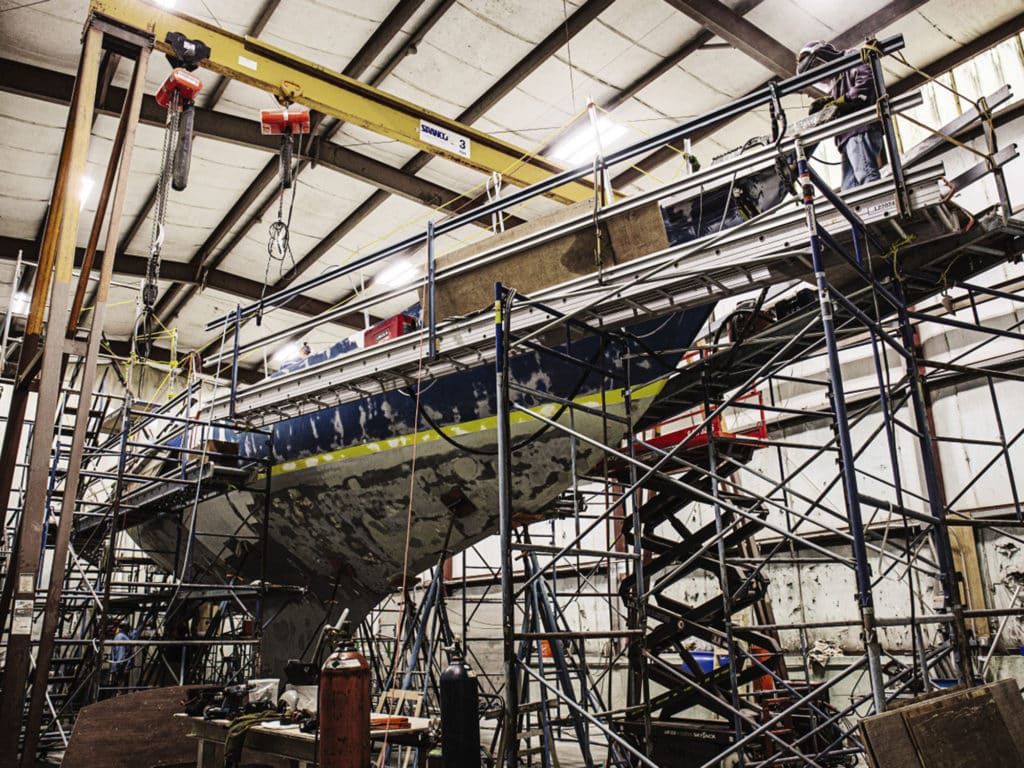
Inside Building No. 5 at Safe Harbor New England Boatworks, Jocko Alpress stands on Running Tide’s new deck. When the boatyard is quiet, he can hear voices from the boat’s past. He was on the boat for seven years, with two owners. On this cold March day, however, quiet reflection isn’t an option for Alpress, who is on the team responsible for the Tide’s comprehensive refit. Those voices are inaudible over a cacophony of power tools as a small army of craftsmen swarm the vessel, which has been stripped to the bones and is in the process of being refaired, repainted, rerigged and reimagined.
Running Tide was built in 1970 by Jakob Isbrandtsen, a shipping magnate and passionate racer, who commissioned Sparkman & Stephens to design a yacht that could beat the likes of Windward Passage, Yankee Girl, Dora and Sorcery—all the hot boats of the day.
Isbrandtsen’s one requirement of Olin Stephens was that Running Tide be 45 feet on the waterline. With the assistance of one of his favorite crewmembers, Vic Romagna—who won the America’s Cup in 1962 aboard Weatherly and again in 1967 aboard Intrepid—Isbrandtsen created the deck layout.
“Nothing against Rod Stephens, but my father was never a fan of his [deck] designs because you were always tripping over sh-t,” says Isbrandtsen’s son, Hans.
The Huisman yard, in the Netherlands, built the aluminum vessel and then shipped it to City Island, New York, to rig the deck at Kretzer Boat Works under the watchful eye of Romagna. “Running Tide was one of the first stripped-out racers,” says Hans Isbrandtsen, whose father passed away in July 2018. “We did the deck layout to sail the boat with eight people. The idea was to have an easy-to-sail boat with people who knew what they were doing.”
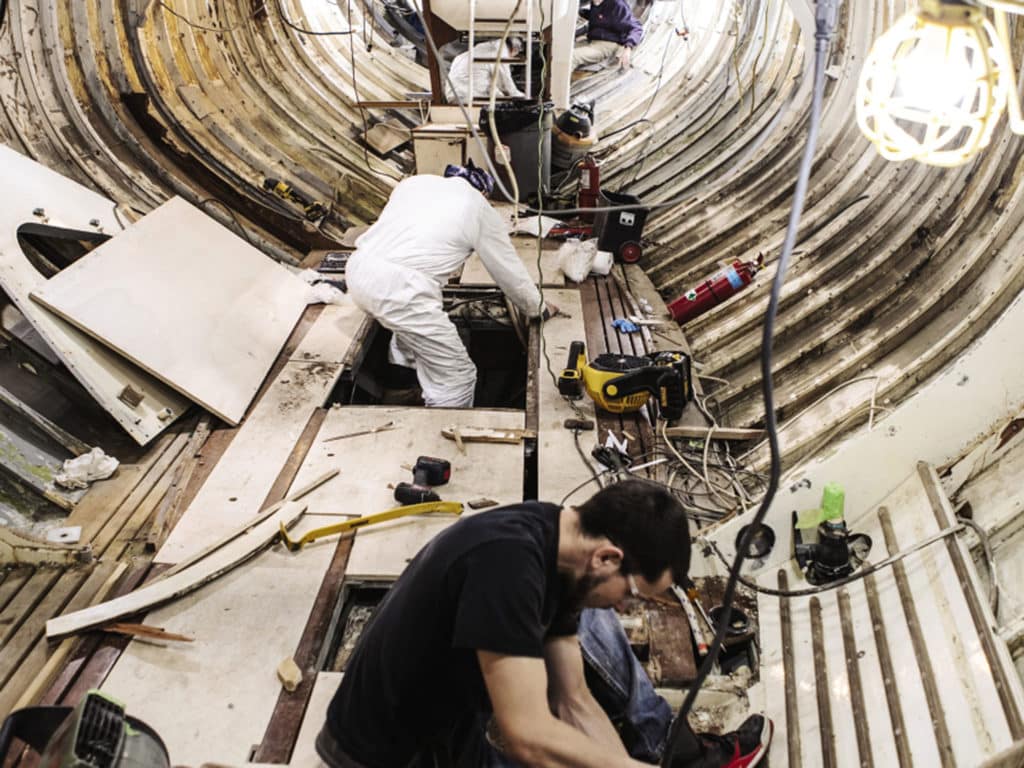
Running Tide’s design was exceptional, as was the camaraderie of its crew. Before Isbrandtsen and his team would sail against the likes of Ted Turner, they squared off against Nazi Germany. Isbrandtsen, too young to enlist in the Navy, was the captain of the yawl Edlu, a 68-foot Sparkman & Stephens design, whose mission was to patrol for Nazi U-boats off Greenport, Long Island.
German U-boats could submerge for only eight hours before they had to surface and run their engines to recharge batteries. When Isbrandtsen and his crew, which included Romagna, spotted a U-boat, they called in air support to bomb them. They assured themselves that the Germans would not waste a torpedo on the likes of Edlu or the other sailing vessels patrolling 10-mile grids. Freighters and US Navy ships were the preferred targets.
The camaraderie and teamwork Isbrandtsen’s crew fostered during their submarine-hunting days was realized decades later when Isbrandtsen assembled the very same crew on Running Tide. They won countless regattas, including the 1971 Southern Ocean Racing Conference, as well as their class in the Bermuda Race. Their results are memorialized with trophies and silver dishes, but the comradeship is what crewmembers remember today.
Bizzy Monte-Sano, part of the team that competed in the Admiral’s Cup in 1963 aboard Windrose, recalls that after the regatta, the crew was relaxing in Isbrandtsen’s home in Cowes, England, when there was a knock on the door. In the vestibule, festooned in full yachting regalia, stood two emissaries of the Royal Yacht Squadron who cordially invited Isbrandtsen and his two watch captains to a cocktail party, the first time nonmembers had been invited to enter the Royal Yacht Squadron.
“It took seven of us to get the boat here, and we would all like to attend,” was Isbrandtsen’s reply, Monte-Sano says. The emissaries said such a thing was not possible, so Isbrandtsen then informed them that he had just checked his calendar and he was going to be busy on that particular evening.
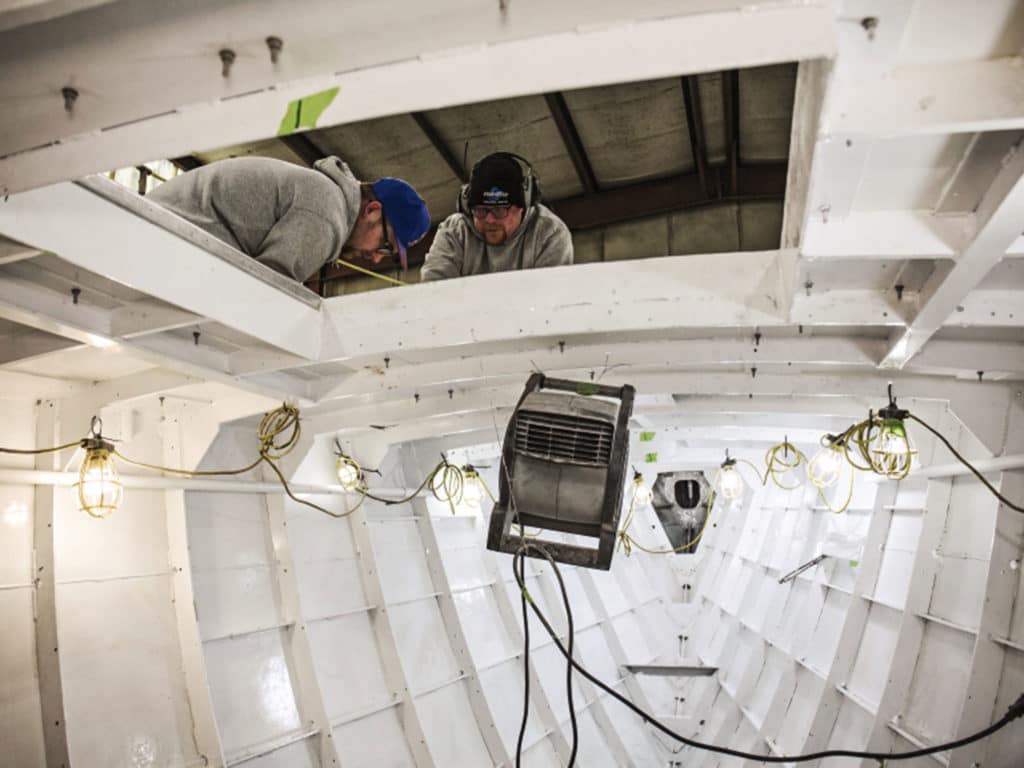
After his business came upon hard times in 1972, Isbrandtsen chartered Running Tide to Turner, who sailed it to victory in numerous races. After the charter period, Running Tide was auctioned off, and Albert Van Metre, a wealthy American developer, was the high bidder. Turner, the second-place bidder, wasn’t amused, so he purchased Lynn Williams’ yacht, Dora IV, and renamed it Tenacious. A rivalry was stoked, and Running Tide kept running, fueled by a new father-and-son team and a band of brothers.
John Marshall, East Coast manager of North Sails at the time, believes Running Tide had soul from the day she was drawn at Sparkman & Stephens. “The Van Metre family had a real reverence for Running Tide,” he says. “It wasn’t just a boat. It was an honor to own it and race it. Al Van Metre always struck a tough deal on a sail. But if I said, ‘Al, Running Tide needs a new genoa,’ he would say, ‘All right—you gotta strike a good price, but let’s do it.’ He never cut a corner to make that boat go better.”
Butch Ulmer, another sailmaker who made his hay in the heyday of offshore yacht racing, estimates he has sailed on more than 200 boats in his lifetime. Running Tide is his favorite. “There were a number of boats that could do everything well,” Ulmer says. “Running Tide was one of those. She was so well-laid-out.”
Van Metre, he says, was the quintessential high-class owner. Even in moments of chaos on deck, he would address the crew as “gentlemen” before he would request a change to the heavy-air jib. His son, Beau, was a good sailor too—a really good sailor, Ulmer says. “He didn’t play the owner’s son. I think Running Tide was, for the sake of a better analogy, the glue that kept Beau and his father together for a lot of years. Running Tide was common ground for both of them.”
During Ulmer’s time on Running Tide, the yacht had a reputation for going upwind well. Downwind, there was room for improvement, so he challenged one of his smartest sail designers, Owen Torrey, to come up with a better spinnaker design. Torrey, a Harvard and Columbia graduate who quit practicing law to become a sailmaker, had a keen mind. In those days, most people used a footlong slide rule, but Torrey’s was 3 feet because it provided him with greater accuracy. Torrey eventually ushered Ulmer to the loft’s roof in City Island. There, flying from the flag pole was a radial-head spinnaker that boasted a beautiful, round, full shape. “This is great, Owen,” Ulmer said. “How the hell did you come up with the design?”
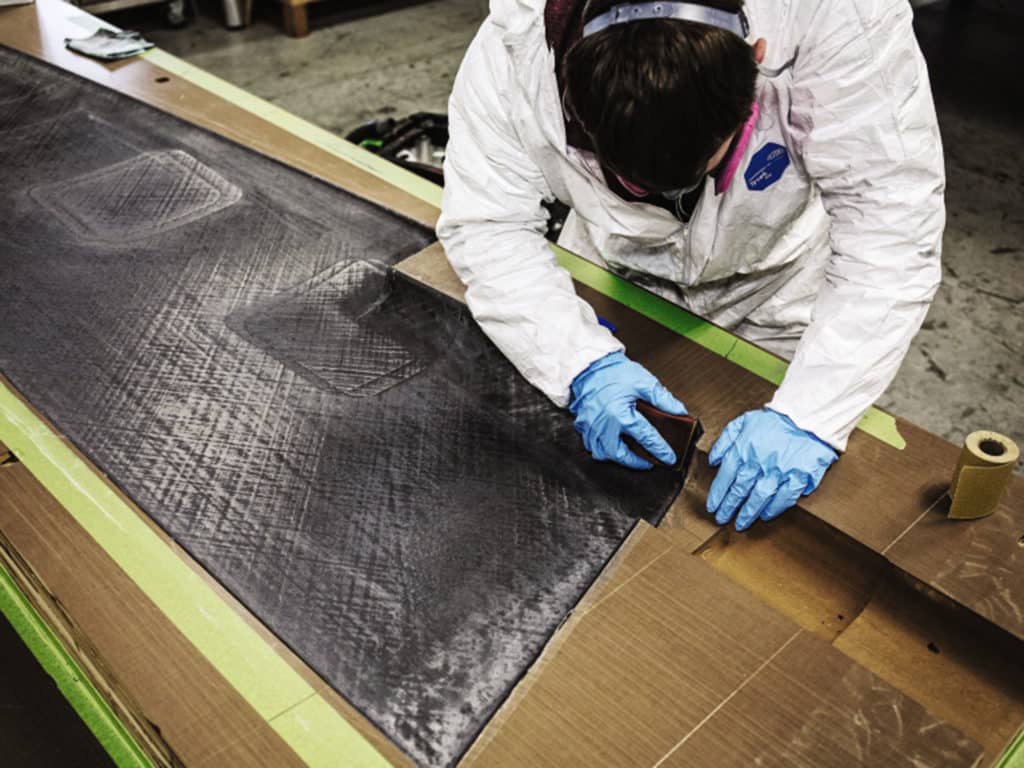
In those days, navigators consulted with Bowditch tables, which were as thick as a dictionary. Torrey found a table that gave him the distance between meridians at a given latitude. He made the head of the spinnaker the north pole, the bottom of the head the equator, and the leeches the two corresponding meridians. The shape was so impressive, Van Metre promptly ordered a few spinnakers from Ulmer.
For 16 years, the Van Metre family and three generations of crew campaigned Running Tide hard. They sailed out of Annapolis, Maryland, in spring, Newport, Rhode Island, in summer, and then delivered it south for the SORC races. For Beau, the wins were exciting, but Running Tide was all about the journey.
By 1986, the young Van Metre retired from racing and sailed Running Tide to France with plans to cruise the Mediterranean and beyond. After the cruise was delayed due to Suez Canal construction, he sold the yacht. “The first guy I sold Running Tide to had the boat for 15 years,” he says. “I’d call every couple of years to see if he was interested in selling. The gentleman had the audacity to ask for $500,000,” Van Metre says, “but I sold him the boat for $175,000, so I thought that was ridiculous.”
Every year, friends racing in St. Tropez would send Van Metre photos of Running Tide. When he started thinking about getting back into sailing, his broker called the most recent owner and queried his interest in selling. The owner was 85, in poor health and ready to sell. The yacht, however, was in rough shape. The plywood deck was cracked, and down below, Van Metre was shocked to find the same cushions, the same gauges, and even the Igloo cooler he had placed on the boat some 35 years earlier.
Its deplorable state would not sway Van Metre’s mind, however. “I knew it needed to be gutted,” he says. “I thought it would be much better for me to own Running Tide and fix it up than to have someone else’s boat or to build a new one.”
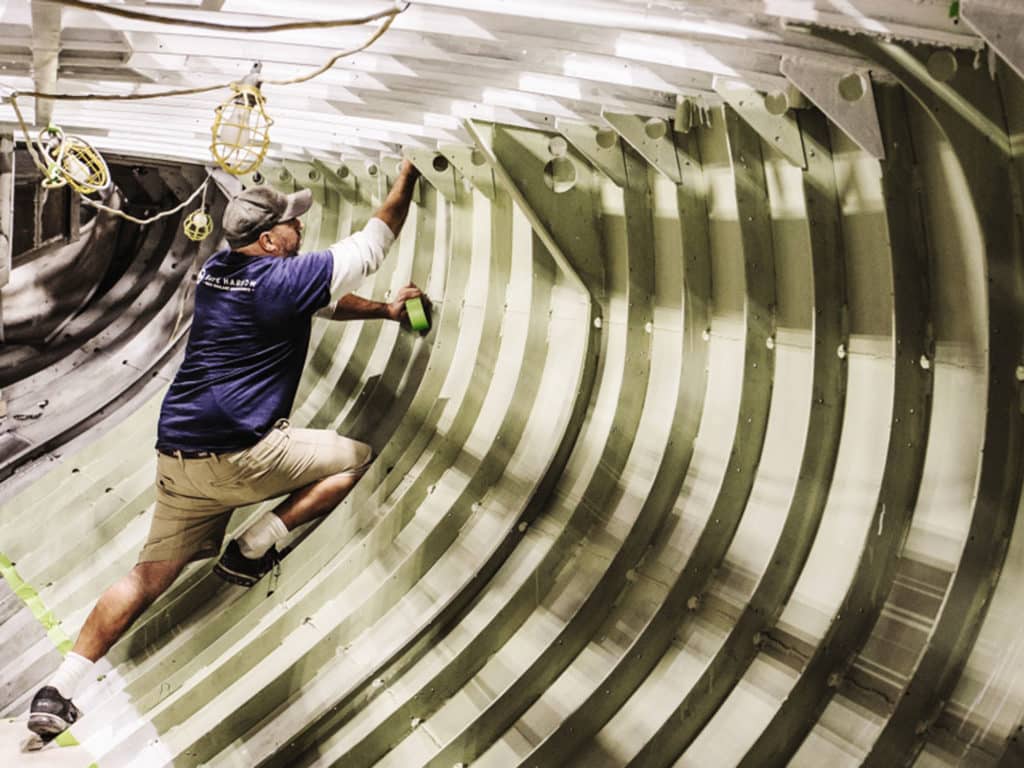
For the refit, Van Metre tapped designer David Pedrick, who knows his way around Sparkman & Stephens yachts, having started his career with the firm in 1970, just about the time Running Tide was launched at Huisman. In Running Tide, Pedrick saw a classic Sparkman & Stephens design that was evolved from 12-Metre designs in general, and Intrepid in particular. “Intuitively, Olin thought about being friendly to the water,” Pedrick says. “He wanted to make it easy for the water to get around the boat.”
Continuous improvement was an ethos in the Sparkman & Stephens office. When Pedrick pulls out a book today with a line drawing of Running Tide, he is quick to note eraser marks over the rudder area. Stephens was always looking forward to the next great idea, never looking back, says Pedrick, so the responsibility of drafting Running Tide’s refit is one he does not take lightly.
“This is one of the most phenomenal, legendary yachts around to be brought back to better-than-original with modern equipment,” he says. “It’s more than a second life. This is a real rejuvenation.”
The goal of Running Tide’s extensive refit, which began in October 2019, is to preserve the yacht’s hard-racing soul, while modifying it so Van Metre can effortlessly daysail it with his wife and family—thus the installation of powered winches. The 2020 Bermuda Race was also on the boat’s reunion tour, but with the race’s cancellation in late March, Van Metre is suddenly afforded the luxury of two more years to whip it into racing shape. Given where they were with the refit in March, it would have been a miracle to cross the starting line in Bristol fashion.
Early on, the decision was made to preserve Running Tide’s 1982-era keel. It was “good enough,” Pedrick says. Changing the keel would be extremely expensive and would also surrender the boat’s age allowance. The eraser marks on the rudder of the original plan were there for a reason, so Pedrick focused on a new rudder. The old skeg-hung rudder was large, low aspect and heavy. The new rudder, a carbon spade hung from the hull, is 200 pounds lighter than the appendage it replaces.
The new rig, built by Offshore Spars, has a carbon standing-rigging package that is one-third the weight of rod rigging. It is 10 feet taller than the original and will carry much more sail area. An additional 300 square feet or so puts the new inventory at 2,023 square feet of high-tech sail area—flatter, more powerful and far less likely to stretch than the Dacron of Tide’s early days.
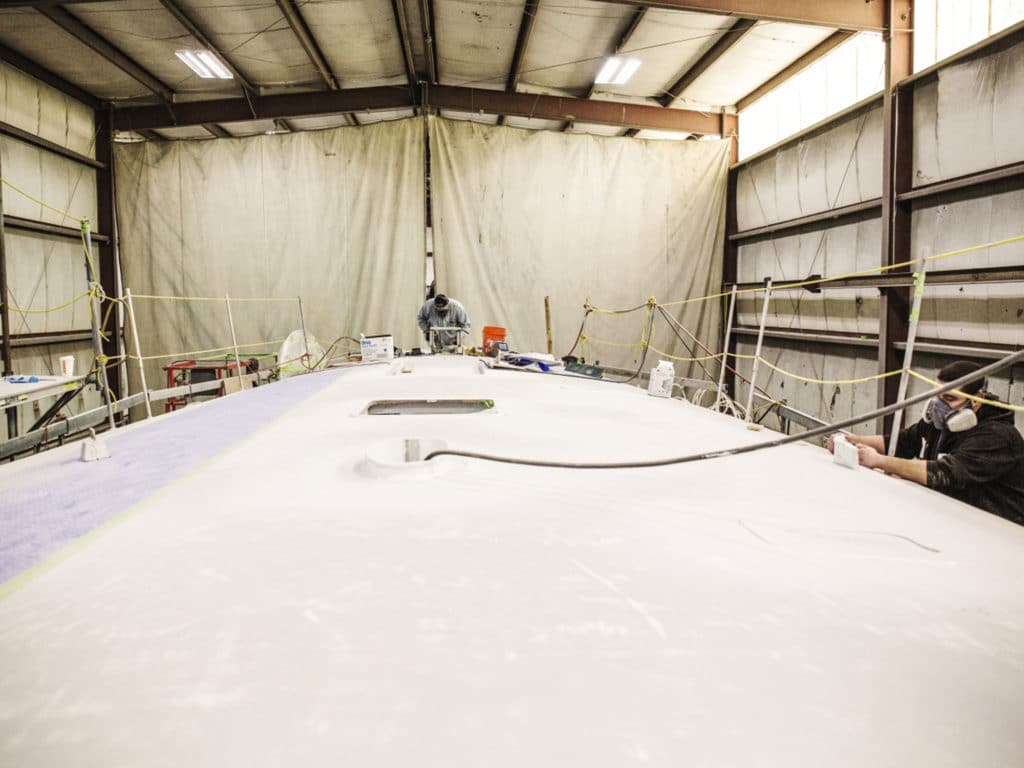
As the vision for Running Tide 2.0 came into sharper focus, plans became shop drawings and shop drawings became hours upon hours of hard labor. For the craftsmen of New England Boatworks, the first back-breaking task was to strip Running Tide to bare hull. When Thomas MacBain, of NEB’s metal department, first saw the boat, he reached a different conclusion than Alpress. “I’m 33 years old. I didn’t know what Running Tide was,” he says. “I thought it was a pile of scrap until I saw the older guys taking pictures of it.”
After stripping paint and filler, the metal department determined that a few parts of the hull required patching, and the shaft log had to be replaced. Pedrick called for significant alterations: new chainplates and frames to support the rig’s higher loads, and the bustle—the area ahead of the rudder—needed to be streamlined.
The aluminum work requires a unique approach, says NEB master welder Abraham Sabala. “Welding it isn’t easy,” he says. “[Aluminum is] a softer material than steel. It heats up quickly and moves, so you have to control the material with jigs and stiffeners. You can’t afford to be off the target, as the margin is slim to none.”
A new ram mast step, engineered to take a 3-ton working load, was installed, as were extensive hydraulics for the push-button winches. Francis Meisenbach, a naval architect at Pedrick’s design firm, used to be a boatbuilder, so when he sends model drawings to Simon Day, an engineer at NEB, he checks their accuracy down to the millimeter. According to Meisenbach, “Slack bilge, long overhang boats like Running Tide don’t have a lot of volume. One of the challenges was fitting in the new amenities.”
Day’s job is to take the engineering drawings from Pedrick and Meisenbach, and turn them into construction plans his team can use to guide the build. “The best place for an engineer to be is upside down in the bilge with a tape measure,” Day says. “The tolerances on the new systems are tight.” As a young engineer, Day is intrigued by the cutting edge of the sport, but he also has great respect for the history: “Speed isn’t everything. Having a story behind what you are doing is almost as important, and in some ways, more.”
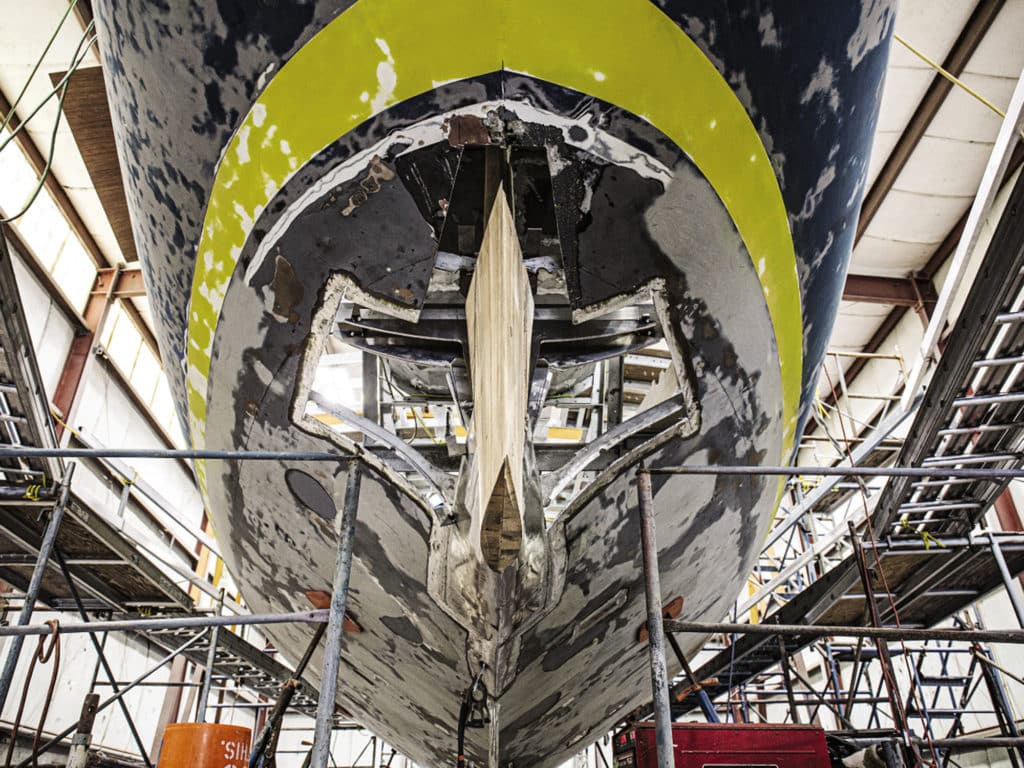
One guiding principle for everyone involved in the project is that Running Tide harken to its past but live in the present with modern technology. This required them to overcome the challenge of adding a furling boom and push-button winches. There was debate over how the winches should be powered. NEB rigging expert PJ Schaffer believed hydraulic was the way to go.
The philosophy behind the rigging, however, is old-school, Schaffer says. “Every good program I’ve been on, the simpler the boat, the better the program. My challenge was to make the boat convertible at the deck level. I want it to be clean so when it’s sitting at the dock and Beau is going cruising with his grandkids, it’s minimal. Two sheets and a mainsheet, you go. But it also needed to work for bluewater sailing and the Bermuda Race.”
Running Tide’s interior is being carefully crafted by Wayne Rego, a master joiner with hands the size of baseball mitts. The new plywood deck went on before the interior went in, so everything Rego and his team builds must first fit through the hatches. To make sure he is fulfilling Van Metre’s vision, Rego built mock-ups of the cabin sole that ranged from highly polished book-matched mahogany to hardwood with more grain. Van Metre chose the grainy wood with more character because it is in keeping with the spirit of the original.
While the team at NEB works on finishing the project throughout the spring, Van Metre is focused on his vision of eventually racing to Bermuda with his son and daughter. “They know the history,” he says, “but they haven’t experienced it.”
It’s March, however, and sailing days are still months away. With a moist southerly licking the outer walls of Building No. 5, Van Metre can practically taste his first summer outing. If all goes to plan, he’ll once again bury the rail of this iconic yacht, with Isbrandtsen, his father, and all those who sailed aboard Running Tide in its glory days, sitting on the weather rail in spirit.









